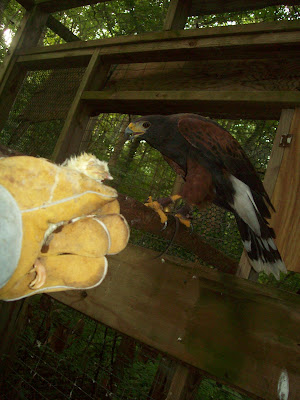
I've been out of the loop for a bit - and for that I apologize. The temperature has finally cooled, and school has started. I'm still working the summer job on the weekends, as well as trying to get the birds to a healthy flying weight (we're real close). The combination of these things has made time a commodity of which I have had little as of late.
Regardless, the getting ready games have begun.
Emails have been flying back and forth as preparations are made for trapping season to begin. A new friend down the coast is helping to trap bait birds.
I've always had a problem with securing enough sparrows

and starlings to use as bait for merlins, so he brought me up a few and I'm housing them in a make shift shed next to the pigeon loft. I've also set my own elevator trap. Hopefully, I'll get one or two in the next few weeks.
I've been checking the
hawk watch counts for the best times to trap. We're after both merlins and Peregrines, their migration time overlap at around the end of September, beginning of October.
I pulled out all my nets, poles, blinds and such to see how they have fared, waiting in the shed for trapping season to roll around. I had forgotten that I had let another trapper borrow my nets, and equipment, so I regarded their storage with trepidation. I hate untangling a net. - let alone three or four.

I set up the blinds, only to find that my oldest ( and cheapest) has lost its shape, and I don't think it will be any use to us this year. Hopefully, some of the other trappers will have blinds they can use. If not - I suppose we could always just use a tent.
The nets beckoned. With the air being cooler, and the humidity lower than it has been all summer, the coming of Fall truly seems like a reality. I am giddy with anticipation. Its silly really how much emotion I have wrapped into all this, but I can't wait.

I pulled the poles apart. The other trapper hadn't stored them the way I would have liked. I unhitched the thread, and then began to unwind the nets. They came apart easily - he did well.
I checked the thread, the knots. Then I wound them back up (my way) and set them back in the corner. I'm about ready - I just need a few things and it won't take long. Trapping will be here before I know it.































